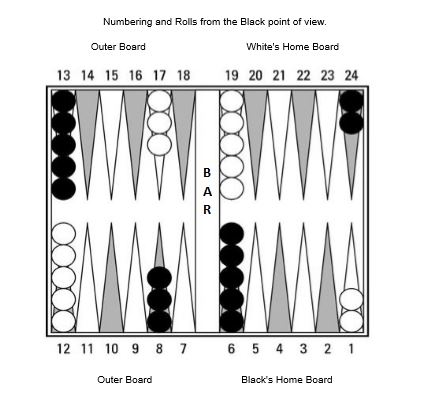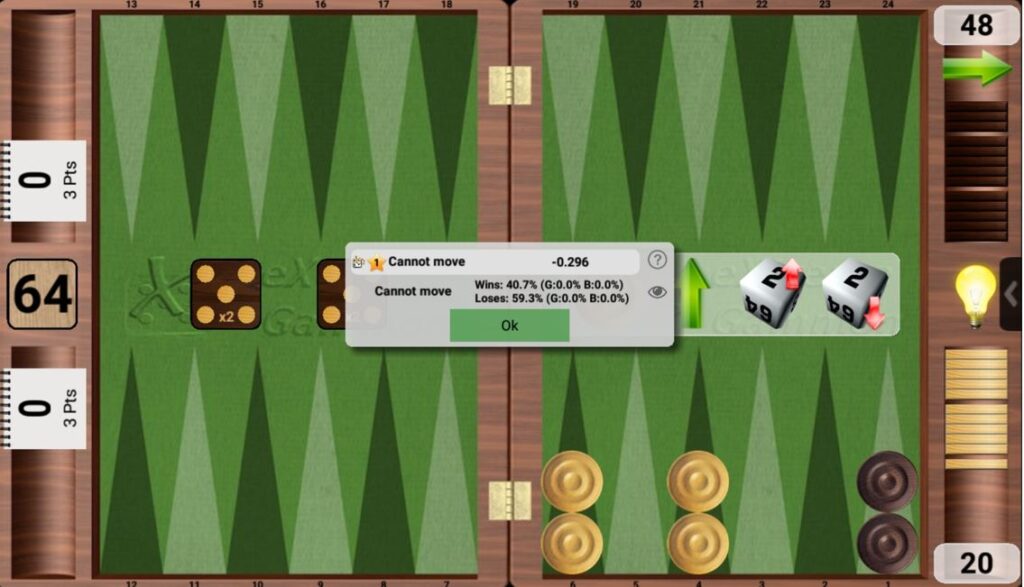Last updated on May 9, 2024
This Deluxe Backgammon post is another in our series for absolute beginners. In this instance, we look at how the checkers move around the board. In simple terms, you cannot play backgammon unless you understand how the checkers move.
Starting the game
At the start of the game, after the board has been set up, each player rolls a single die. The dice roll should be made using a dice cup, which is specially designed to prevent the rolls from being manipulated. This initial roll determines both the player to go first and the specific numbers to be played. If equal numbers are rolled, then both players roll again until they roll different numbers. The player throwing the higher number now moves their checkers according to the numbers showing on both dice. The player making the first move will not roll the dice again, but instead will use the numbers as shown in the opening roll. For example, if player A rolls 6 and player B rolls 4, then player A makes the first move using the roll 6-4. After the first roll, the players each roll two dice and alternate turns.
Roll of the dice
The roll of the dice indicates how many points, or pips, the player can move their checkers. The checkers are always moved forward, to a lower-numbered point. For example, in the diagram below, black must move counter-clockwise around the board from the 24-point towards the 1-point.
The following rules dictate the allowed moves:
Open points
A checker may only be moved to an open point, one that is not occupied by two or more opposing checkers. A point occupied by a single opposing checker is known as a blot and is considered an open point. If an opposing checker lands on a blot, the blot is hit and placed on the bar. You can also land your checkers on points occupied by your checkers. There is no limit to the number of checkers you may have on a single point.
Two dice
The numbers on the two dice represent separate moves. For example, if a player rolls 3 and 1. They can move one checker 3 spaces to an open point and another checker 1 space to an open point. Alternatively, they can move checker a total of 4 spaces to an open point. However, this is only if the intermediate points are also open. In this example, the checker would make separate moves of 1 and 3, in either order, to make a total move of 4.
Doubles
A player who rolls doubles plays the numbers shown on the dice twice. For example, a roll of 5-5 means that the player has four moves of 5 to make. They may move any combination of checkers in accordance with the rules above.
Legal moves
A player must use both numbers of a roll if this is legally in accordance with the rules above. For doubles, all four numbers should be played. If only one number can be played, the player must play that number and forfeit the other roll. Additionally, if either number can be played but not both, the player must play the higher one. When neither number can be used, the player loses their turn. In the case of doubles, when all four numbers cannot be played, the player must play as many numbers as they can.
Bearing off
Once a player has moved all of their fifteen checkers into their home board, they may begin to bear off. A player bears off a checker by rolling a number that corresponds to the point on which the checker resides, and then removing that checker from the board. For example, a 6 permits the player to bear off a checker from the six-point.
If there is no checker on the point indicated by the roll, the player must make a legal move using a checker on a higher-numbered point. If there are no checkers on higher-numbered points, the player is required to bear off a checker from the highest point on which one of their checkers occupies. A player is under no obligation to bear off if they can otherwise make a legal move. In the example below, the white player is unable to move because the double 5 roll is blocked by the 1-point.
A player must have all of their active checkers in their home board in order to bear off. If a checker is hit during the bearing off process it is sent to the bar. The player must then re-enter the checker and return it to their home board before continuing to bear off. The first player to bear off all fifteen checkers wins the game.
Related content
Backgammon opening moves, a simple list.
Backgammon, 3 simple tips for beginners.
How backgammon checkers move by HowStuffWorks.




Nice simple explanation about how to move the checkers in backgammon. Perfect for backgammon beginners.